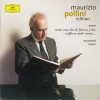Composers
Luigi Nono (January 29, 1924 – May 8, 1990) was an Italian avant-garde composer of classical music and remains one of the most prominent composers of the 20th century.
Born in Venice, he was a member of a wealthy artistic family, and his grandfather was a notable painter. Nono began music lessons with Gian Francesco Malipiero in 1941 at the Venice Conservatory where he acquired knowledge of the Renaissance madrigal tradition, amongst other styles. After graduating with a degree in law from the University of Padua, he was given encouragement in composition by Bruno Maderna. Through Maderna, he became acquainted with Hermann Scherchen—then Maderna's conducting teacher—who gave Nono further tutelage and was an early mentor and advocate of his music.
It was Scherchen who presented Nono's first acknowledged work, the Variazioni canoniche sulla serie dell'op. 41 di A. Schönberg in 1950, at the Internationale Ferienkurse für Neue Musik Darmstadt—a centre for the rediscovery of modern music after the devastation of dictatorship and war. The Variazioni canoniche, based on the twelve-tone series of Arnold Schoenberg's Op. 41, including the Ode-to-Napoleon hexachord, marked Nono as a committed composer of anti-fascist political orientation (Annibaldi 1980). (Variazioni canoniche also used a six-element row of rhythmic values). Nono had been a member of the Italian Resistance during the Second World War (Schoenberg-Nono, 2008). In fact Nono's striking political commitment, while allying him with some of his contemporaries at Darmstadt such as Henri Pousseur and in the earlier days Hans Werner Henze, distinguished him from others, including Pierre Boulez and Karlheinz Stockhausen. Nevertheless, it was with Boulez and Stockhausen that Nono became one of the leaders of the New Music during the 1950s.
A number of Nono's early works were first performed at Darmstadt, including Tre epitaffi per Federico García Lorca (1951–53), La Victoire de Guernica (1954)—modeled after Picasso's painting as an indictment of the war-time atrocity—and Incontri (1955). The Liebeslied (1954) was written for Nono's wife-to-be, Nuria Schoenberg (daughter of Arnold Schoenberg), whom he met at the 1953 world première of Moses und Aron in Hamburg. They married in 1955. Nono had enrolled as a member of the Italian Communist Party in 1952 (Flamm 1995).
The world première of Il canto sospeso (1955–56) for solo voices, chorus, and orchestra brought Nono international recognition and acknowledgment as the legitimate successor to Webern. "Reviewers noted with amazement that Nono's canto sospeso achieved a synthesis—to a degree hardly thought possible—between an uncompromisingly avant-garde style of composition and emotional, moral expression (in which there was an appropriate and complementary treatment of the theme and text)" (Flamm 1995).
This work, regarded as one of the central masterpieces of the 1950s (Stenzl 1986b), is a commemoration of the victims of Fascism, incorporating farewell letters written by political prisoners before execution. Musically, Nono breaks new ground, not only by the "exemplary balance between voices and instruments" (Annibaldi 1980) but in the motivic, point-like vocal writing in which words are fractured into syllables exchanged between voices to form floating, diversified sonorities—which may be likened to an imaginative extension of Schoenberg's "Klangfarbenmelodie technique" (Flamm 1995, IX). Nono himself emphasized his lyrical intentions in an interview with Hansjörg Pauli (Pauli 1971, quoted in Flamm 1995, IX), and a connection to Schoenberg's Survivor from Warsaw is postulated by Guerrero 2006.
Nono took strong exception, and informed Stockhausen that it was "incorrect and misleading, and that he had had neither a phonetic treatment of the text nor more or less differentiated degrees of comprehensibility of the words in mind when setting the text" (footnote in Stockhausen 1964, 49).
Il canto sospeso has been described as an "everlasting warning" (Annibaldi 1980); indeed, it is a powerful refutation to the apparent claim made in an often-cited, but out-of-context phrase (cf. Hofmann 2005) from philosopher Theodor W. Adorno that "to write poetry after Auschwitz is barbaric" (Adorno 1981, 34).
Nono was to return to such anti-fascist subject matter again, as in Diario polacco; Composizione no. 2 (1958–59), whose background included a journey through the Nazi concentration camps, and the "azione scenica" Intolleranza 1960, which caused a riot at its première in Venice, on 13 April 1961 (Steinitz 1995, Schoenberg-Nono 2005).
It was Nono who, in his 1958 lecture "Die Entwicklung der Reihentechnik" (Nono 1975, 21–33), created the expression "Darmstadt School" to describe the music composed during the 1950s by himself and Pierre Boulez, Bruno Maderna, Karlheinz Stockhausen, and other composers not specifically named by him (Nono 1975, 30). He likened their significance to the Bauhaus in the visual arts and architecture (Nono 1975, 30).
On 1 September 1959, Nono delivered at Darmstadt a polemically charged lecture written in conjunction with his pupil Helmut Lachenmann, "Geschichte und Gegenwart in der Musik von Heute" ("History and Presence in the Music of Today"), in which he criticised and distanced himself from the composers of chance and aleatoric music, then in vogue, under the influence of American models such as John Cage (Nono 1975, 34–40). Although in a seminar a few days earlier Stockhausen had described himself as "perhaps the extreme antipode to Cage", when he spoke of "statistical structures" at the concert devoted to his works on the evening of the same day, the Marxist Nono saw this in terms of "fascist mass structures" and a violent argument erupted between the two friends (Kurtz 1992, 98). In combination with Nono's strongly negative reaction to Stockhausen's interpretation of text-setting in Il canto sospeso, this effectively ended their friendship until the 1980s, and thus disbanded the "avant-garde trinity" of Boulez, Nono, and Stockhausen (Schoenberg-Nono 2005).
Intolleranza 1960 may be viewed as the culmination of the composer's early style and aesthetics (Annibaldi 1980). The plot concerns the plight of an emigrant captured in a variety of scenarios relevant to modern capitalist society: working class exploitation, street demonstrations, political arrest and torture, concentration camp internment, refuge, and abandonment. Described as a "stage-action"—Nono explicitly forbade the title of opera (Stenzl, 1999) —it utilizes an array of resources from large orchestra, chorus, tape, and loudspeakers to the "magic lantern" technique drawn from Meyerhold and Mayakovsky theatre practices of the 1920s to form a rich, expressionist drama. Angelo Ripellino's libretto consisting of political slogans, poems, and quotations from Brecht and Sartre (including moments of Brechtian alienation), together with Nono's strident, anguished music, fully accords with the anti-capitalist fulmination the composer intended to communicate (Annibaldi 1980). The riot at the première in Venice was significantly due to the presence of both left- and right-wing political factions in the audience. Neo-nazis had attempted to disrupt proceedings with stink-bombs, nonetheless failing to prevent the performance ending triumphantly for Nono (Schoenberg-Nono 2005). Intolleranza is dedicated to Schoenberg.
During the 1960s, Nono's musical activities became increasingly explicit and polemical in their subject, whether that be the warning against nuclear catastrophe (Canti di vita e d'amore: sul ponte di Hiroshima of 1962), the denunciation of capitalist exploitation (La Fabbrica Illuminata, 1964), the condemnation of Nazi war criminals in the wake of the Frankfurt Auschwitz trials (Ricorda cosi ti hanno fatto in Auschwitz, 1965) or of American imperialism in the war against Vietnam (A floresta é jovem e cheia de vida, 1966). Nono began to incorporate documentary material (political speeches, slogans, extraneous sounds) on tape, and a new use of electronics, that he felt necessary to produce the "concrete situations" relevant to contemporary political issues (Annibaldi 1980). The instrumental writing tended to conglomerate the 'punctual' serial style of the early 1950s into groups, clusters of sounds—broadstrokes that effectively complimented the use of tape collage (Annibaldi 1980). In keeping with his Marxist convictions as 'reinterpreted' through the writings of Antonio Gramsci (Flamm 1995, Koch, 1972), he brought this radical music out of the concert hall into universities, trade-unions and factories where he gave lectures and performances. The title of "A floresta é jovem e cheia de vida" as given in Portuguese usually contains a spelling error which continues to be perpetuated in references to the work. The title may be translated into English as "The Forest is Young and Full of Life". The correct Portuguese spelling of the word "full" is "cheia", and not "cheja" as often rendered in citing this work. The phrase itself occurs as one of the eight declamations of the work, reputedly being the words of an Angolan guerrilla fighter by the name of Gabriel: "They cannot burn the forest, for it is young and full of life" (Davezies 1965,).
Nono's second period commonly thought to have begun after Intolleranza (Annibaldi 1980) reaches its apogee in his second "azione scenica", Al gran sole carico d'amore (1972–74)—a collaboration with Yuri Lyubimov, who was then director of the Taganka Theatre in Moscow. In this large-scale stage work, Nono completely dispenses with a dramatic narrative, and presents pivotal moments in the history of Communism and class-struggle "side-by-side" to produce his "theatre of consciousness". The subject matter (as evident from the quotations from manifestos and poems, Marxist classics to the anonymous utterances of workers) deals with failed revolutions; the Paris Commune of 1871, the 1905 Russian Revolution, and the revolt of freedom fighters in 1960s Chile under the leadership of Che Guevara and Tania Bunke. Then extremely topical, Al gran sole offers a multi-lateral spectacle and a moving meditation on the history of twentieth-century communism, as viewed through the prism of Nono's music. It was premiered at the Teatro Lirico, Milan in 1975.
During this time, Nono visited Soviet Russia where he awakened the interest of Alfred Schnittke, among others, in the contemporary practices of avant-garde composers of the West (Ivashkin 1996,). Indeed, the 1960s and 70s were marked by frequent travels abroad, lecturing in Latin America, and making the acquaintance of leading left-wing intellectuals and activists (Archivo Luigi Nono, Biography-Timeline). It was to mourn the assassination of Luciano Cruz, a leader of the Chilean Revolutionary Front, that Nono composed Como una ola fuerza y luz (1972). Very much in the bold, expressionist style of Al gran sole, with the use of large orchestra, tape and electronics, it became a kind of piano concerto with added vocal commentary.
Nono returned to the piano (with tape) for his next piece, ...Sofferte onde serene… (1976), written for his friend Maurizio Pollini after the common bereavement of two of their relatives (See Nono's Programme note|Col Legno,1994). With this work began a radically new, intimate phase of the composer's development—by way of Con Luigi Dallapicolla for percussion and electronics (1978) to Fragmente-Stille, an Diotima for string quartet (1980). One of Nono's most demanding works (both for performers and listeners), Fragmente-Stille is music on the threshold of silence. The score is interspersed with 53 quotations from the poetry of Hölderlin addressed to his "lover" Diotima, which are to be "sung" silently by the players during performance, striving for that "delicate harmony of inner life" (Hölderlin). A sparse, highly concentrated work commissioned by the Beethoven Festival in Bonn, Fragmente-Stille reawakened great interest in Nono's music throughout Germany (Loescher 2000).
Nono had been introduced to the Venice-based philosopher, Massimo Cacciari (Mayor of Venice from 1993–2000), who began to have an increasing influence on the composer's thought during the 1980s (Carvalho 1999). Through Cacciari, Nono became immersed in the work of many German philosophers, including the writings of Walter Benjamin whose ideas on history (strikingly similar to the composer's own) formed the background to the monumental Prometeo—tragedia dell' ascolto (1984/85) (Stenzl, 1995). Nono's late music is haunted by Benjamin's philosophy, especially the concept of history (Über den Begriff der Geschichte) which is given a central role in Prometeo.
Musically, Nono began to experiment with the new sound possibilities and production at the Experimentalstudio der Heinrich-Strobel-Stiftung des SWF in Freiburg. There, he devised a whole new approach to composition and technique, frequently involving the contributions of specialist musicians and technicians to realise his aims (Fabbriciani 1999).The first fruits of these collaborations were Das atmende Klarsein (1981–82), Diario polacco II (1982)—an indictment against Soviet Cold War tyranny—and Guai ai gelidi mostri (1983). The new technologies allowed the sound to circulate in space, giving this dimension a role no less important than its emission. Such innovations became central to a new conception of time and space (Pestalozza 1992). These highly impressive masterworks were partly preparation for what many regard as his greatest achievement.
Prometeo has been described as "one of the best works of the 20th century" (Beyst 2003). After the theatrical excesses of Al gran sole, which Nono later remarked were a "monster of resources" (Stenzl, 1995), the composer began to think along the lines of an opera or rather a 'musica per dramatica' without any visual, stage dimension. In short, a drama in music—"the tragedy of listening"—the subtitle a poignant comment on consumerism today. Hence, in the vocal parts the most simple intervalic procedures (mainly 4ths and 5ths) profoundly resonate amidst a tapestry of harsh, dissonant, microtonal writing for the ensembles.
Prometeo is perhaps the ultimate realisation of Nono's "theatre of consciousness"—here, an invisible theatre in which the production of sound and its projection in space become fundamental to the overall dramaturgy. The architect Renzo Piano designed an enormous 'wooden boat' structure for the première at San Lorenzo church in Venice, whose acoustics must to some extent be reconstructed for each performance. (For the Japanese première at the Akiyoshidai Festival (Shuho), the new concert hall was named 'Prometeo Hall' in Nono's honour, and designed by leading architect Arata Isozaki) (Casa Ricordi Online, Historical Background). The libretto incorporates disparate texts by Hesiod, Hölderlin, and Benjamin (mostly logistically inaudible during performance due to Nono's characteristic deconstruction), which explore the origin and evolution of humanity, as compiled and expanded by Cacciari. In Nono's timeless and visionary context, music and sound predominate over the image and the written word to form new dimensions of meaning and "new possibilities" for listening.
Nono's last masterpieces, such as Caminantes… Ayacucho (1986–87), inspired by a region in southern Peru that experiences extreme poverty and social unrest, La lontananza nostalgica utopica futura (1988–89), and "Hay que caminar" soñando (1989), offer poignant comment on the composer's life-long quest for political renewal and social justice.
Nono died in Venice in 1990. After his funeral, the German composer Dieter Schnebel remarked that he "was a very great man" (Loescher, 2000)—a sentiment widely shared by those who knew him, and those who have come to admire his music (Davismoon 1999a). Nono is buried on the island of San Michele, alongside other such artistic luminaries as Stravinsky, Diaghilev, and Ezra Pound.
The full impact of Nono's art, especially the late music, has only just begun to take effect in the English-speaking world. His music has been shamefully ignored by the BBC Proms festival over the past few decades. Perhaps the three most important collections of Nono's writings on music, art, and politics (Texte: Studien zu seiner Musik (1975), Ecrits (1993), and Scritti e colloqui (2001)), as well as the texts collected in Restagno 1987, have yet to be translated into English. By contrast, Nono's influence has been widely felt on the European continent by such composers as György Kurtág, Wolfgang Rihm, Helmut Lachenmann, Salvatore Sciarrino, Heinz Holliger, Brian Ferneyhough, and Nicolaus A. Huber. Other distinguished admirers include architect Daniel Liebeskind and novelist Umberto Eco (Das Nonoprojekt), for Nono totally reconstructed music and engaged in the most fundamental issues with regards to its expressivity.
In 1993 the Luigi Nono Archives were established through the efforts of Nuria Schoenberg Nono for the purpose of housing and conserving the Luigi Nono legacy. For a complete list of Nono's works, please see the Archivio Luigi Nono.
Recently Added
Biography
Luigi Nono (January 29, 1924 – May 8, 1990) was an Italian avant-garde composer of classical music and remains one of the most prominent composers of the 20th century.
Born in Venice, he was a member of a wealthy artistic family, and his grandfather was a notable painter. Nono began music lessons with Gian Francesco Malipiero in 1941 at the Venice Conservatory where he acquired knowledge of the Renaissance madrigal tradition, amongst other styles. After graduating with a degree in law from the University of Padua, he was given encouragement in composition by Bruno Maderna. Through Maderna, he became acquainted with Hermann Scherchen—then Maderna's conducting teacher—who gave Nono further tutelage and was an early mentor and advocate of his music.
It was Scherchen who presented Nono's first acknowledged work, the Variazioni canoniche sulla serie dell'op. 41 di A. Schönberg in 1950, at the Internationale Ferienkurse für Neue Musik Darmstadt—a centre for the rediscovery of modern music after the devastation of dictatorship and war. The Variazioni canoniche, based on the twelve-tone series of Arnold Schoenberg's Op. 41, including the Ode-to-Napoleon hexachord, marked Nono as a committed composer of anti-fascist political orientation (Annibaldi 1980). (Variazioni canoniche also used a six-element row of rhythmic values). Nono had been a member of the Italian Resistance during the Second World War (Schoenberg-Nono, 2008). In fact Nono's striking political commitment, while allying him with some of his contemporaries at Darmstadt such as Henri Pousseur and in the earlier days Hans Werner Henze, distinguished him from others, including Pierre Boulez and Karlheinz Stockhausen. Nevertheless, it was with Boulez and Stockhausen that Nono became one of the leaders of the New Music during the 1950s.
A number of Nono's early works were first performed at Darmstadt, including Tre epitaffi per Federico García Lorca (1951–53), La Victoire de Guernica (1954)—modeled after Picasso's painting as an indictment of the war-time atrocity—and Incontri (1955). The Liebeslied (1954) was written for Nono's wife-to-be, Nuria Schoenberg (daughter of Arnold Schoenberg), whom he met at the 1953 world première of Moses und Aron in Hamburg. They married in 1955. Nono had enrolled as a member of the Italian Communist Party in 1952 (Flamm 1995).
The world première of Il canto sospeso (1955–56) for solo voices, chorus, and orchestra brought Nono international recognition and acknowledgment as the legitimate successor to Webern. "Reviewers noted with amazement that Nono's canto sospeso achieved a synthesis—to a degree hardly thought possible—between an uncompromisingly avant-garde style of composition and emotional, moral expression (in which there was an appropriate and complementary treatment of the theme and text)" (Flamm 1995).
This work, regarded as one of the central masterpieces of the 1950s (Stenzl 1986b), is a commemoration of the victims of Fascism, incorporating farewell letters written by political prisoners before execution. Musically, Nono breaks new ground, not only by the "exemplary balance between voices and instruments" (Annibaldi 1980) but in the motivic, point-like vocal writing in which words are fractured into syllables exchanged between voices to form floating, diversified sonorities—which may be likened to an imaginative extension of Schoenberg's "Klangfarbenmelodie technique" (Flamm 1995, IX). Nono himself emphasized his lyrical intentions in an interview with Hansjörg Pauli (Pauli 1971, quoted in Flamm 1995, IX), and a connection to Schoenberg's Survivor from Warsaw is postulated by Guerrero 2006.
Nono took strong exception, and informed Stockhausen that it was "incorrect and misleading, and that he had had neither a phonetic treatment of the text nor more or less differentiated degrees of comprehensibility of the words in mind when setting the text" (footnote in Stockhausen 1964, 49).
Il canto sospeso has been described as an "everlasting warning" (Annibaldi 1980); indeed, it is a powerful refutation to the apparent claim made in an often-cited, but out-of-context phrase (cf. Hofmann 2005) from philosopher Theodor W. Adorno that "to write poetry after Auschwitz is barbaric" (Adorno 1981, 34).
Nono was to return to such anti-fascist subject matter again, as in Diario polacco; Composizione no. 2 (1958–59), whose background included a journey through the Nazi concentration camps, and the "azione scenica" Intolleranza 1960, which caused a riot at its première in Venice, on 13 April 1961 (Steinitz 1995, Schoenberg-Nono 2005).
It was Nono who, in his 1958 lecture "Die Entwicklung der Reihentechnik" (Nono 1975, 21–33), created the expression "Darmstadt School" to describe the music composed during the 1950s by himself and Pierre Boulez, Bruno Maderna, Karlheinz Stockhausen, and other composers not specifically named by him (Nono 1975, 30). He likened their significance to the Bauhaus in the visual arts and architecture (Nono 1975, 30).
On 1 September 1959, Nono delivered at Darmstadt a polemically charged lecture written in conjunction with his pupil Helmut Lachenmann, "Geschichte und Gegenwart in der Musik von Heute" ("History and Presence in the Music of Today"), in which he criticised and distanced himself from the composers of chance and aleatoric music, then in vogue, under the influence of American models such as John Cage (Nono 1975, 34–40). Although in a seminar a few days earlier Stockhausen had described himself as "perhaps the extreme antipode to Cage", when he spoke of "statistical structures" at the concert devoted to his works on the evening of the same day, the Marxist Nono saw this in terms of "fascist mass structures" and a violent argument erupted between the two friends (Kurtz 1992, 98). In combination with Nono's strongly negative reaction to Stockhausen's interpretation of text-setting in Il canto sospeso, this effectively ended their friendship until the 1980s, and thus disbanded the "avant-garde trinity" of Boulez, Nono, and Stockhausen (Schoenberg-Nono 2005).
Intolleranza 1960 may be viewed as the culmination of the composer's early style and aesthetics (Annibaldi 1980). The plot concerns the plight of an emigrant captured in a variety of scenarios relevant to modern capitalist society: working class exploitation, street demonstrations, political arrest and torture, concentration camp internment, refuge, and abandonment. Described as a "stage-action"—Nono explicitly forbade the title of opera (Stenzl, 1999) —it utilizes an array of resources from large orchestra, chorus, tape, and loudspeakers to the "magic lantern" technique drawn from Meyerhold and Mayakovsky theatre practices of the 1920s to form a rich, expressionist drama. Angelo Ripellino's libretto consisting of political slogans, poems, and quotations from Brecht and Sartre (including moments of Brechtian alienation), together with Nono's strident, anguished music, fully accords with the anti-capitalist fulmination the composer intended to communicate (Annibaldi 1980). The riot at the première in Venice was significantly due to the presence of both left- and right-wing political factions in the audience. Neo-nazis had attempted to disrupt proceedings with stink-bombs, nonetheless failing to prevent the performance ending triumphantly for Nono (Schoenberg-Nono 2005). Intolleranza is dedicated to Schoenberg.
During the 1960s, Nono's musical activities became increasingly explicit and polemical in their subject, whether that be the warning against nuclear catastrophe (Canti di vita e d'amore: sul ponte di Hiroshima of 1962), the denunciation of capitalist exploitation (La Fabbrica Illuminata, 1964), the condemnation of Nazi war criminals in the wake of the Frankfurt Auschwitz trials (Ricorda cosi ti hanno fatto in Auschwitz, 1965) or of American imperialism in the war against Vietnam (A floresta é jovem e cheia de vida, 1966). Nono began to incorporate documentary material (political speeches, slogans, extraneous sounds) on tape, and a new use of electronics, that he felt necessary to produce the "concrete situations" relevant to contemporary political issues (Annibaldi 1980). The instrumental writing tended to conglomerate the 'punctual' serial style of the early 1950s into groups, clusters of sounds—broadstrokes that effectively complimented the use of tape collage (Annibaldi 1980). In keeping with his Marxist convictions as 'reinterpreted' through the writings of Antonio Gramsci (Flamm 1995, Koch, 1972), he brought this radical music out of the concert hall into universities, trade-unions and factories where he gave lectures and performances. The title of "A floresta é jovem e cheia de vida" as given in Portuguese usually contains a spelling error which continues to be perpetuated in references to the work. The title may be translated into English as "The Forest is Young and Full of Life". The correct Portuguese spelling of the word "full" is "cheia", and not "cheja" as often rendered in citing this work. The phrase itself occurs as one of the eight declamations of the work, reputedly being the words of an Angolan guerrilla fighter by the name of Gabriel: "They cannot burn the forest, for it is young and full of life" (Davezies 1965,).
Nono's second period commonly thought to have begun after Intolleranza (Annibaldi 1980) reaches its apogee in his second "azione scenica", Al gran sole carico d'amore (1972–74)—a collaboration with Yuri Lyubimov, who was then director of the Taganka Theatre in Moscow. In this large-scale stage work, Nono completely dispenses with a dramatic narrative, and presents pivotal moments in the history of Communism and class-struggle "side-by-side" to produce his "theatre of consciousness". The subject matter (as evident from the quotations from manifestos and poems, Marxist classics to the anonymous utterances of workers) deals with failed revolutions; the Paris Commune of 1871, the 1905 Russian Revolution, and the revolt of freedom fighters in 1960s Chile under the leadership of Che Guevara and Tania Bunke. Then extremely topical, Al gran sole offers a multi-lateral spectacle and a moving meditation on the history of twentieth-century communism, as viewed through the prism of Nono's music. It was premiered at the Teatro Lirico, Milan in 1975.
During this time, Nono visited Soviet Russia where he awakened the interest of Alfred Schnittke, among others, in the contemporary practices of avant-garde composers of the West (Ivashkin 1996,). Indeed, the 1960s and 70s were marked by frequent travels abroad, lecturing in Latin America, and making the acquaintance of leading left-wing intellectuals and activists (Archivo Luigi Nono, Biography-Timeline). It was to mourn the assassination of Luciano Cruz, a leader of the Chilean Revolutionary Front, that Nono composed Como una ola fuerza y luz (1972). Very much in the bold, expressionist style of Al gran sole, with the use of large orchestra, tape and electronics, it became a kind of piano concerto with added vocal commentary.
Nono returned to the piano (with tape) for his next piece, ...Sofferte onde serene… (1976), written for his friend Maurizio Pollini after the common bereavement of two of their relatives (See Nono's Programme note|Col Legno,1994). With this work began a radically new, intimate phase of the composer's development—by way of Con Luigi Dallapicolla for percussion and electronics (1978) to Fragmente-Stille, an Diotima for string quartet (1980). One of Nono's most demanding works (both for performers and listeners), Fragmente-Stille is music on the threshold of silence. The score is interspersed with 53 quotations from the poetry of Hölderlin addressed to his "lover" Diotima, which are to be "sung" silently by the players during performance, striving for that "delicate harmony of inner life" (Hölderlin). A sparse, highly concentrated work commissioned by the Beethoven Festival in Bonn, Fragmente-Stille reawakened great interest in Nono's music throughout Germany (Loescher 2000).
Nono had been introduced to the Venice-based philosopher, Massimo Cacciari (Mayor of Venice from 1993–2000), who began to have an increasing influence on the composer's thought during the 1980s (Carvalho 1999). Through Cacciari, Nono became immersed in the work of many German philosophers, including the writings of Walter Benjamin whose ideas on history (strikingly similar to the composer's own) formed the background to the monumental Prometeo—tragedia dell' ascolto (1984/85) (Stenzl, 1995). Nono's late music is haunted by Benjamin's philosophy, especially the concept of history (Über den Begriff der Geschichte) which is given a central role in Prometeo.
Musically, Nono began to experiment with the new sound possibilities and production at the Experimentalstudio der Heinrich-Strobel-Stiftung des SWF in Freiburg. There, he devised a whole new approach to composition and technique, frequently involving the contributions of specialist musicians and technicians to realise his aims (Fabbriciani 1999).The first fruits of these collaborations were Das atmende Klarsein (1981–82), Diario polacco II (1982)—an indictment against Soviet Cold War tyranny—and Guai ai gelidi mostri (1983). The new technologies allowed the sound to circulate in space, giving this dimension a role no less important than its emission. Such innovations became central to a new conception of time and space (Pestalozza 1992). These highly impressive masterworks were partly preparation for what many regard as his greatest achievement.
Prometeo has been described as "one of the best works of the 20th century" (Beyst 2003). After the theatrical excesses of Al gran sole, which Nono later remarked were a "monster of resources" (Stenzl, 1995), the composer began to think along the lines of an opera or rather a 'musica per dramatica' without any visual, stage dimension. In short, a drama in music—"the tragedy of listening"—the subtitle a poignant comment on consumerism today. Hence, in the vocal parts the most simple intervalic procedures (mainly 4ths and 5ths) profoundly resonate amidst a tapestry of harsh, dissonant, microtonal writing for the ensembles.
Prometeo is perhaps the ultimate realisation of Nono's "theatre of consciousness"—here, an invisible theatre in which the production of sound and its projection in space become fundamental to the overall dramaturgy. The architect Renzo Piano designed an enormous 'wooden boat' structure for the première at San Lorenzo church in Venice, whose acoustics must to some extent be reconstructed for each performance. (For the Japanese première at the Akiyoshidai Festival (Shuho), the new concert hall was named 'Prometeo Hall' in Nono's honour, and designed by leading architect Arata Isozaki) (Casa Ricordi Online, Historical Background). The libretto incorporates disparate texts by Hesiod, Hölderlin, and Benjamin (mostly logistically inaudible during performance due to Nono's characteristic deconstruction), which explore the origin and evolution of humanity, as compiled and expanded by Cacciari. In Nono's timeless and visionary context, music and sound predominate over the image and the written word to form new dimensions of meaning and "new possibilities" for listening.
Nono's last masterpieces, such as Caminantes… Ayacucho (1986–87), inspired by a region in southern Peru that experiences extreme poverty and social unrest, La lontananza nostalgica utopica futura (1988–89), and "Hay que caminar" soñando (1989), offer poignant comment on the composer's life-long quest for political renewal and social justice.
Nono died in Venice in 1990. After his funeral, the German composer Dieter Schnebel remarked that he "was a very great man" (Loescher, 2000)—a sentiment widely shared by those who knew him, and those who have come to admire his music (Davismoon 1999a). Nono is buried on the island of San Michele, alongside other such artistic luminaries as Stravinsky, Diaghilev, and Ezra Pound.
The full impact of Nono's art, especially the late music, has only just begun to take effect in the English-speaking world. His music has been shamefully ignored by the BBC Proms festival over the past few decades. Perhaps the three most important collections of Nono's writings on music, art, and politics (Texte: Studien zu seiner Musik (1975), Ecrits (1993), and Scritti e colloqui (2001)), as well as the texts collected in Restagno 1987, have yet to be translated into English. By contrast, Nono's influence has been widely felt on the European continent by such composers as György Kurtág, Wolfgang Rihm, Helmut Lachenmann, Salvatore Sciarrino, Heinz Holliger, Brian Ferneyhough, and Nicolaus A. Huber. Other distinguished admirers include architect Daniel Liebeskind and novelist Umberto Eco (Das Nonoprojekt), for Nono totally reconstructed music and engaged in the most fundamental issues with regards to its expressivity.
In 1993 the Luigi Nono Archives were established through the efforts of Nuria Schoenberg Nono for the purpose of housing and conserving the Luigi Nono legacy. For a complete list of Nono's works, please see the Archivio Luigi Nono.
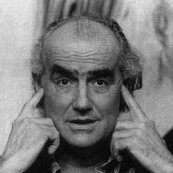
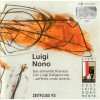
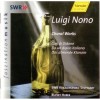
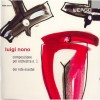
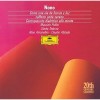
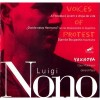
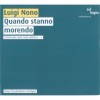
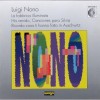


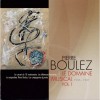
![Anthology of the Royal Concertgebouw Orchestra: Live the Radio Recordings 1960-1970 [CD9]](http://static.classicalm.com/repository/disk-cover/small/3446-img1395223793797033.jpg)
